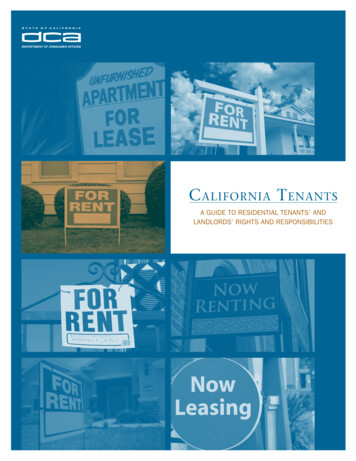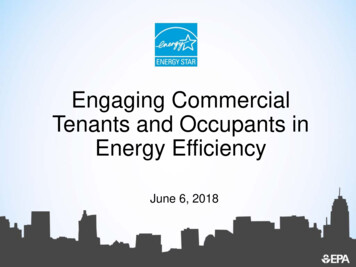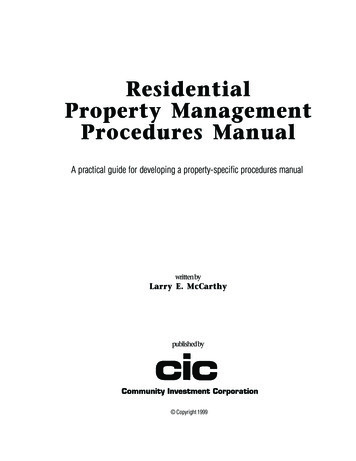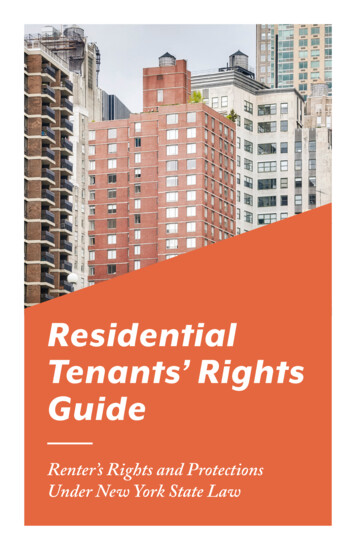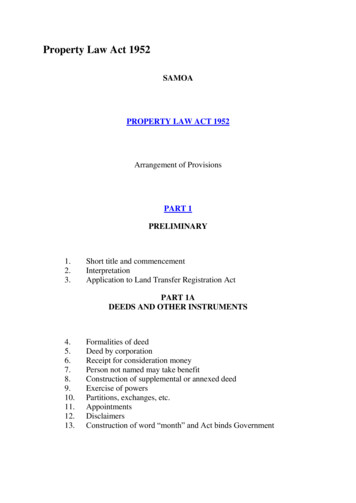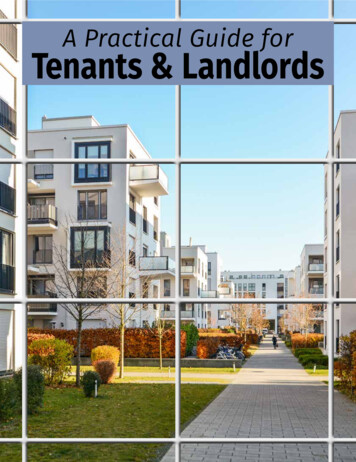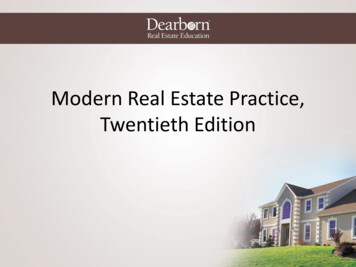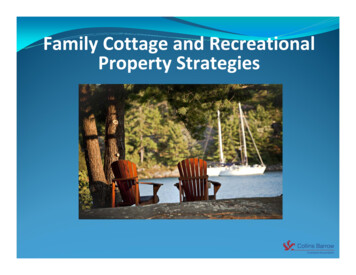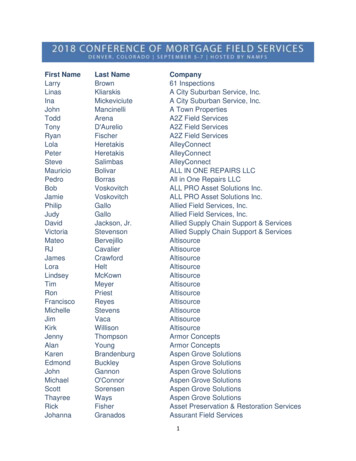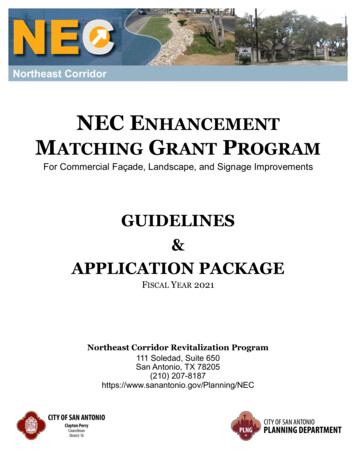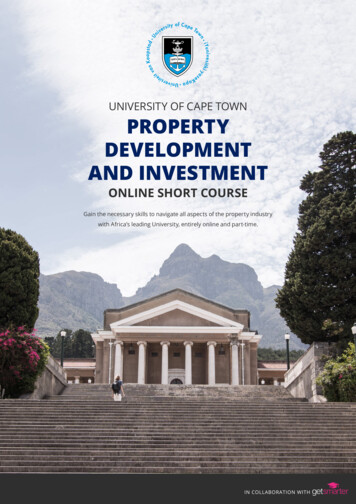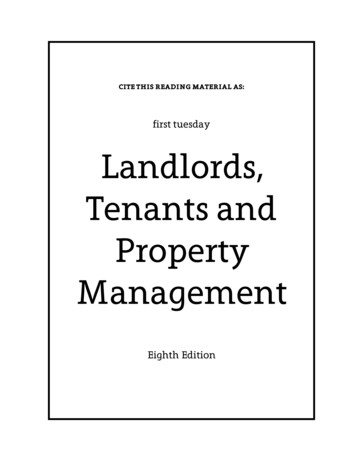
Transcription
CITE THIS READING MATERIAL AS:first tuesdayLandlords,Tenants andPropertyManagementEighth Edition
Cutoff Dates:Legal editing of this book wascompleted June 2014.Monthly updates of this text, including errata and recent developments,are available on your Student Homepage at firsttuesday.us.Copyright 2014 by first tuesdayP.O. Box 5707, Riverside, CA 92517All rights reserved. No part of this publication may be reproduced or transmitted in any form or by any means, electronic or mechanical, including photocopy,recording, or any information storage or retrieval system, without permission inwriting from the publisher.Printed in CaliforniaEditorial StaffLegal Editor/Publisher:Fred CraneProject Editor:Connor P. WallmarkSenior Editor:Giang Hoang-BurdetteContributing Editors:Fernando NuñezCarrie B. ReyesMatthew TaylorSarah KolvasGraphic Designer:Mary LaRochelleComments or suggestions to:first tuesday, P.O. Box 5707, Riverside, CA 92517editorial@firsttuesday.us
Table of ContentsTable of Forms.ivIntroduction.viGlossary.441Chapter 1Fee vs. leaseholdA matter of possession. . . . . . . . . . . . . . . . . . . . . . . . . . . . . . . . . . . . . . . 1Chapter 2The tenancies in real estateKnow your tenancy or lose time. . . . . . . . . . . . . . . . . . . . . . . . . . . . . . . 9Chapter 3Landlord’s right to enterConflict with occupant’s right to privacy. . . . . . . . . . . . . . . . . . . . 21Chapter 4Tenant leasehold improvementsOwnership rights when a tenant vacates . . . . . . . . . . . . . . . . . . . 37Chapter 5Options and the right of first refusal to buyTenants with rights to acquire the premises. . . . . . . . . . . . . . . . . 51Chapter 6Property management licensingWhen is a CalBRE license required?. . . . . . . . . . . . . . . . . . . . . . . . . 61Chapter 7Property management agreementAuthority to operate a rental property. . . . . . . . . . . . . . . . . . . . . . 69Chapter 8A property manager’s responsibilitiesAn evolving standard of conduct. . . . . . . . . . . . . . . . . . . . . . . . . . . . . 77Chapter 9Resident managersEmployees: not independent contractors, not tenants . . . . . 95Chapter 10Identification of property manager or ownerNotice to tenant of agent-for-service. . . . . . . . . . . . . . . . . . . . . . . . 107Chapter 11Exclusive authorization to leaseLeasing agent’s bargain for fees. . . . . . . . . . . . . . . . . . . . . . . . . . .113Chapter 12Exclusive authorization to locate spaceA leasing agent and the nonresidential tenant. . . . . . . . . . . 123Chapter 13Cost of operating in leased spaceDisclosures by leasing agents. . . . . . . . . . . . . . . . . . . . . . . . . . . . . . . 133iTable anagement
iiLandlords, Tenants and Property Management, Eighth nanciesMaintenanceandSecurityChapter 14Security deposits and pre-expiration inspectionsCover for a tenant’s nonperformance . . . . . . . . . . . . . . . . . . . . . 141Chapter 15Residential turnover cost recoveryRent is set to include all operating expenses. . . . . . . . . . . . . . . . 155Chapter 16Accepting partial rentResidential and nonresidential landlord rights. . . . . . . . . . . 163Chapter 17Changing terms on a month-to-month tenancyLandlord’s notice to tenant. . . . . . . . . . . . . . . . . . . . . . . . . . . . . . . . . . 171Chapter 18Forfeiture of the leaseLease agreement obligations survive . . . . . . . . . . . . . . . . . . . . . . . 179Chapter 19Surrender cancels the lease agreementLost ability to recover future rents. . . . . . . . . . . . . . . . . . . . . . . . . . 191Chapter 20Delinquent rent and the three-day noticePay or forfeit your right of possession . . . . . . . . . . . . . . . . . . . . . . 201Chapter 21Three-day notices to quit for nonmonetary breachesCurable and incurable nonmonetary breaches . . . . . . . . . . . . 213Chapter 22Other amounts due under three-day noticesKnow what the judge will allow. . . . . . . . . . . . . . . . . . . . . . . . . . . . 231Chapter 23Notices to vacateTermination of periodic tenancies . . . . . . . . . . . . . . . . . . . . . . . . . 241Chapter 24Personal property recovered by tenantReclaim it on notice or lose it . . . . . . . . . . . . . . . . . . . . . . . . . . . . . . . . 255Chapter 25Constructive eviction cancels the leaseInterference forces the tenant to vacate. . . . . . . . . . . . . . . . . . . . 267Chapter 26Care and maintenance of propertyTenant obligations and remedies. . . . . . . . . . . . . . . . . . . . . . . . . . . . 277Chapter 27Implied warranty of habitabilitySafe and sanitary living conditions. . . . . . . . . . . . . . . . . . . . . . . . . 289Chapter 28Security to prevent crimesProtective measures and warnings . . . . . . . . . . . . . . . . . . . . . . . . 303Chapter 29Dangerous on-site and off-site activitiesDuty to all to remove on-site dangers . . . . . . . . . . . . . . . . . . . . . . . 309
Table of ContentsChapter 30Nonresidential lease agreementsThe conveyance of a leasehold . . . . . . . . . . . . . . . . . . . . . . . . . . . . . 321Chapter 31Rent provisions in nonresidential leasesSetting the rent. . . . . . . . . . . . . . . . . . . . . . . . . . . . . . . . . . . . . . . . . . . . 341Chapter 32Adjustable rent provisionsEconomic goals of nonresidential landlords. . . . . . . . . . . . . . . 349Chapter 33Nonresidential use-maintenance provisionsShifting ownership obligations to tenants. . . . . . . . . . . . . . . . . 359Chapter 34Lease assignments and subleasesConsent conditioned on exactions . . . . . . . . . . . . . . . . . . . . . . . . . 373Chapter 35Residential rental and lease agreementsA review of periodic vs. fixed-term tenancies. . . . . . . . . . . . . . 385Chapter 36Civil rights and fair housing lawsProperty rights and an individual’s status. . . . . . . . . . . . . . . . . . 395Chapter 37Residential rent controlPolice power and rent control. . . . . . . . . . . . . . . . . . . . . . . . . . . . . . 411Chapter 38Attornment clauses in nonresidential leasesAltering priorities for lenders . . . . . . . . . . . . . . . . . . . . . . . . . . . . . . 419Chapter 39Due-on-leasing regulationsRising interest rates bring lender interference. . . . . . . . . . . . es andRentalAgreementsLenderConsiderations
ivLandlords, Tenants and Property Management, Eighth EditionTable ofFormsFullFormsFull-size, fillable copies of all 350 first tuesday forms can be foundin the Forms-on-CD accompanying this course.No.Form NamePage111Exclusive Authorization to Locate Space. 127113Schedule of Leasing Agent’s Fee. 332116Right to Enter and Exhibit Unit to Buyers —For Residential and Nonresidential Rentals.26116-1Notice to Occupant of Entry and Completion of Showing —For Residential and Nonresidential Rentals.27161Standard Option to Purchase —Irrevocable Right-to-Buy.54552Nonresidential Lease Agreement Addendum —Alienation of Leasehold. 383554Change of Owner of Property Manager —Addendum to Rental or Lease Agreement. 110558Partial Payment Agreement — Nonresidential. 165559Partial Payment Agreement — Residential. 168560Condition of Premises Addendum. 278561Condition of Furnishings Addendum —And Inventory. 280562Tenant’s Property Operating Expense Profile. 136567Notice of Intent to Enter Dwelling.25567-1Notice of Right to Request aJoint Pre-Expiration Inspection. 146567-3Statement of Deficiencies onJoint Pre-Expiration Inspection. 14856930-Day Notice to Vacate —For Use by Residential Landlord. 243569-160-Day Notice to Vacate –For Use by Residential Landlord. 24457030-Day Notice of Change in Rental Terms. 17357230-Day Notice to Vacate — From Tenant. 17457390-Day Notice to Quit Due to Foreclosure —To Holdover Residential Tenant. 252575Three-Day Notice to Pay Rent or Quit —With Rent-Related Fees. 203
Table of FormsNo.Form NamePage575-1Three-Day Notice to Pay Rent or Quit —Without Rent-Related Fees. 235576Three-Day Notice to Perform or Quit. 215577Three-Day Notice to Quit —Residential and Nonresidential. 217579Right of First Refusal to Buy — Addendum.57580Proof of Service —For Service of Notice to Real Estate Tenants. 225582Notice to Landlord to Surrender Personal Property —For Use by Residential Tenants Only. 259582-1Costs Payable to Reclaim Personal Property. 265584Notice of Right to Reclaim Personal Property —To Residential Tenant After Termination of Tenancy. 257584-1Notice of Right to Reclaim Personal Property —To Others with an Interest in Property. 261585Security Deposit DispositionOn Vacating Residential Premises. 150587Termination of Lease and Surrender Agreement. 194591Resident Manager Agreement.98597Notice of Nonresponsibility —From Landlord (Calif.Civil Code §3094).47110Exclusive Authorization to Lease Property. 115135Request for Homeowner Association Documents.74163Lease-Option – Contract for Deed.59185Letter of Intent. 137352Annual Property Operating Data Sheet (APOD). 161436-1UCC-1 Financing Statement.48550Residential Lease Agreement. 387552Nonresidential Lease Agreement — Single Tenant Gross.6, 323, .346, 350, 351, 361-363, 368-370, 374, 382, 429552-4Nonresidential Lease Agreement — Percentage Lease. 355552-8Lender Subordination and Attornment Provisions. 421, 427590Property Management Agreement.71PartialFormsv
viLandlords, Tenants and Property Management, Eighth EditionIntroductionLandlords, Tenants and Property Management is written for realestate licensees, landlords, property managers, attorneys and investors.The course material is designed to be an educational tool for use in theclassroom and in correspondence studies as well as a strong technicalresearch and reference tool.The objective of Landlords, Tenants and Property Managementis to inform the reader of federal, state and local landlord/tenant rightsand obligations. This book examines the exacting rules of leasing andrenting both residential and nonresidential income properties. Alsoincluded are examples that vividly present and resolve landlord/tenant situations encountered by owners and real estate licenseeswho manage income property or perform services as leasing agents.A distinction exists between nonresidential (commercial, industrial,etc.) and residential landlord-tenant relationships. This distinctionlies in the residential rental exception carved out of the general, longstanding landlord-tenant rules once applicable to both residential andnonresidential property. General landlord-tenant rules apply fully tononresidential leasing arrangements and, to the extent not overriddenby extensive residential exceptions, apply to residential leasingarrangements as well.Included in each chapter is a summary of issues reviewed in thechapter with definitions of the key terms essential to the reader’scomprehension of the topic. Unless a form cited in the book says, “SeeForm XXX accompanying this chapter” [emphasis added], it is notin the book. However, the reader has access to a fillable and savableversion of all referenced first tuesday forms on the first tuesdayForms-on-CD delivered with the course enrollment package. The CDcontains 400 first tuesday real estate forms, plus a digital versionof our library of the sixteen volumes comprising the first tuesdayRealtipedia publication.All materials are also accessible online from the reader’s StudentHomepage at www.firsttuesday.us during their one-year enrollmentperiod.Future errata, supplemental material and recent developments specificto Landlords, Tenants and Property Management are availablefor further research within the Online Reading section of the reader’sStudent Homepage at www.firsttuesday.us.
Chapter 1: Fee vs. leaseholdChapter1Fee vs. leaseholdAfter reading this chapter, you will be able to: identify the different possessory interests held in real estate, andthe rights and obligations associated with each; distinguish the individual rights which collectively comprise realproperty; identify the different types of leasehold interests held by tenants; understand leasehold interests which convey special rights, suchas a ground lease, master lease or sublease.estatelife estatefee estatemaster leasefixed-term tenancyparcelground leaseprofit a prendreimpairmentsubleaseleasehold estatetenancy-at-sufferancelegal descriptiontenancy-at-willReal estate, sometimes legally called real property or realty, consists of: the land; the improvements and fixtures attached to the land; and all rights incidental or belonging to the property.11 Calif. Civil Code §658LearningObjectivesKey TermsA matter ofpossession1
2Landlords, Tenants and Property Management, Eighth EditionparcelA three-dimensionalportion of real estateidentified by a legaldescription.legal descriptionThe description usedto locate and setboundaries for a parcelof real estate.A parcel of real estate is located by circumscribing its legal description onthe “face of the earth.” Based on the legal description, a surveyor locates andsets the corners and surface boundaries of the parcel. The legal description iscontained in deeds, subdivision maps or government surveys relating to theproperty.All permanent structures, crops and timber are part of the parcel of real estate.The parcel of real estate also includes buildings, fences, trees, watercoursesand easements within the parcel’s boundaries.A parcel of real estate is three dimensional. In addition to the surface areawithin the boundaries, a parcel of real estate consists of: the soil below the parcel’s surface to the core of the earth, includingwater and minerals; and the air space above it to infinity.For instance, the rental of a boat slip includes the water and the land belowit. Both the water and land below the boat slip comprise the real estate, theparcel leased. Thus, landlord/tenant law controls the rental of the slip.In the case of a statutory condominium unit, the air space enclosed withinthe walls is the real estate conveyed and held by the fee owner of the unit.The structure, land and air space outside the unit are the property of thehomeowners’ association (HOA).Possessoryinterests inreal estateestateThe ownership interesta person may hold inreal estate.The ownership interests a person may hold in real estate are called estates.Four types of estates exist in real estate: fee estates, also known as fee simple estates, inheritance estates,perpetual estates, or simply, the fee; life estates; leasehold estates, sometimes called leaseholds, or estates for years; and estates at will, also known as tenancies-at-will.2In practice, these estates are separated into three categories: fee estates,life estates and leasehold estates. Estates at will are considered part of theleasehold estates category. Leasehold estates are controlled by landlord/tenant law.Fee estates:unbundlingthe rightsfee estateAn indefinite, exclusiveand absolute legalownership interest in aparcel of real estate.A person who holds a fee estate interest in real estate is a fee owner. In alandlord/tenant context, the fee owner is the landlord.Editor’s note — If a sublease exists on a nonresidential property, the mastertenant is the “landlord” of the subtenant.A fee owner has the right to possess and control their property indefinitely.A fee owner’s possession is exclusive and absolute. Thus, the owner has the2 CC §761
Chapter 1: Fee vs. leaseholdConsider a fee owner who grants separate fee interests in their property to two individuals.One individual receives the land’s surface and air space rights. The other individual receivesthe subsurface oil and mineral rights.The surface owner claims title to the entire parcel of real estate should be vested — quieted— in their name. The subsurface owner objects, claiming the surface owner’s real estateinterest is less than the entire fee estate in the property.Case in pointSeparation offee interestsHere, the surface owner’s fee interest in the parcel of real estate is separate from thesubsurface ownership and possession of the oil and mineral rights. Also, they are not coowners of the real estate. Both owners hold an individual fee estate in mutually exclusiveand divided portions of the same parcel. [In re Waltz (1925) 197 C 263]right to deny others permission to cross their boundaries. No one can be onthe owner’s property without their consent, otherwise they are trespassing.The owner may recover any money losses caused by the trespass.A fee owner has the exclusive right to use and enjoy the property. As long aslocal ordinances such as building codes and zoning regulations are obeyed, afee owner may do as they please with their property. A fee owner may buildnew buildings, tear down old ones, plant trees and shrubs, grow crops orsimply leave the property unattended.A fee owner may occupy, sell, lease or encumber their parcel of real estate,give it away or pass it on to anyone they choose on their death. The fee estateis the interest in real estate transferred in a real estate sales transaction, unlessa lesser interest such as an easement or life estate is noted. However, onecannot transfer an interest greater than they received.A fee owner is entitled to the land’s surface and anything permanentlylocated above or below it.3The ownership interests in one parcel may be separated into several feeinterests. One person may own the mineral rights beneath the surface,another may own the surface rights, and yet another may own the rightsto the air space. Each solely owned interest is held in fee in the same parcel.[See Case in point, “Separation of fee interests”]In most cases, one or more individuals own the entire fee and lease therights to extract underground oil or minerals to others. Thus, a fee ownercan convey a leasehold estate in the oil and minerals while retaining theirfee interest. The drilling rights separated from the fee ownership are calledprofit a prendre.4Profit a prendre is the right to remove profitable materials from propertyowned and possessed by another. If the profit a prendre is created by a leaseagreement, it is a type of easement.53 CC §8294 Rousselot v. Spanier (1976) 60 C3d 2385 Gerhard v. Stephens (1968) 68 C2d 864Separateinterestsprofit a prendreThe right to removeminerals fromanother’s real estate.3
4Landlords, Tenants and Property Management, Eighth EditionLife estatesand the lifetenantlife estateAn interest in a parcelof real estate lastingthe lifetime of the lifetenant.A life estate is an interest in a parcel of real estate lasting the lifetime of anindividual, usually the life of the tenant. Life estates are granted by a deedentered into by the fee owner, an executor under a will or by a trustee underan inter vivos trust.Life estates are commonly established by a fee owner who wishes to providea home or financial security for another person (the life tenant) during thatperson’s lifetime, called the controlling life.Life estates terminate on the death of the controlling life. Life estates may alsobe terminated by agreement or by merger of different ownership interests inthe property.For example, the fee owner of a vacation home has an elderly aunt whoneeds a place to live. The fee owner grants her a life estate in the vacationhome for the duration of her lifetime. The aunt may live there for the rest ofher life, even if she outlives the fee owner who granted her the life estate.Although the aunt has the right of exclusive possession of the entire parcel ofreal estate, the fee owner retains title to the fee estate. Thus, the conveyanceof a life estate transfers a right of possession which has been “carved out” ofthe fee estate. This is comparable to possession under a leasehold estate sinceit is conveyed for its duration out of a fee estate. Unlike a lease, a life estatedoes not require rent to be paid.On the aunt’s death, possession of the property reverts to the fee owner, theirsuccessors or heirs. The right of possession under the life estate is extinguishedon the aunt’s death.The holder of a life estate based on their life has the right of possession untildeath, as though they were the owner in fee. The holder of a life estate isresponsible for taxes, maintenance and a reasonable amount of propertyassessments.6The life estateimproves orimpairs thefeeimpairmentThe act of injuring ordiminishing the valueof a fee interest.The holder of a life estate may not impair the fee interest.7For instance, the holder of a life estate may not make alterations whichdecrease the property’s value, such as removing or failing to care for valuableplants or demolishing portions of the improvements or land.Conversely, the owner of the life estate has the right to lease the property toothers and collect and retain all rents produced by the property during theterm of the life estate.In addition, a life tenant is entitled to be reimbursed by the fee owner for thefee owner’s share of the costs to improve the property.6 CC §8407 CC §818
Chapter 1: Fee vs. leaseholdLeasehold estates, or tenancies, are the result of rights conveyed to a tenantby a fee owner (or by the life estate tenant or master lessee) to possess a parcelof real estate.Tenancies are created when the landlord and the tenant enter into a rentalor lease agreement that conveys a possessory interest in the real estate to thetenant.The tenant becomes the owner of a leasehold with the right to possess anduse the entire property until the lease expires. The ownership and title tothe fee interest in the property remains with the landlord throughout theterm of the leasehold. The landlord’s fee interest is subject to the tenant’sright of possession, which is carved out of the fee on entering into the leaseagreement.5Leaseholdestates heldby tenantsleasehold estateThe right to possessa parcel of land,conveyed by a feeowner (landlord) to atenant.In exchange for the right to occupy and use the property, the landlord isentitled to rental income from the tenant during the period of the tenancy.Four types of leasehold estates exist and can be held by tenants. The interestsare classified by the length of their term: a fixed-term tenancy, simply known as a lease and legally called anestate for years; a periodic tenancy, usually referred to as a rental; a tenancy-at-will, previously introduced as an estate at will; and a tenancy-at-sufferance, commonly called a holdover tenancy.A fixed-term tenancy lasts for a specific length of time as stated in a leaseagreement entered into by a landlord and tenant. On expiration of the leaseterm, the tenant’s right of possession automatically terminates unless it isextended or renewed by another agreement, such as an option agreement.[See Figure 1, Form 552 §2]Periodic tenancies also last for a specific length of time, such as a week,month or year. Under a periodic tenancy, the landlord and tenant agreeto automatic successive rental periods of the same length of time, such asin a month-to-month tenancy, until terminated by notice by either thelandlord or the tenant.In a tenancy-at-will (also known as an estate at will) the tenant has theright to possess a property with the consent of the fee owner. Tenancies-atwill can be terminated at any time by an advance notice from either thelandlord or the tenant or as set by agreement. Tenancies-at-will do not havea fixed duration, are usually not in writing and a rent obligation generallydoes not exist.A tenancy-at-sufferance occurs when a tenant retains possession of therented premises after the tenancy granted terminates. [See Chapter 2]Types ofleaseholdsfixed-term tenancyA leasehold interestwhich lasts forthe specific leaseperiod set forth in alease agreement. Afixed-term tenancyautomaticallyterminates at the endof the lease period. [Seeft Form 550 and 552]tenancy-at-willA leasehold interestgranted to a tenant,with no fixed durationor rent owed. Atenancy-at-will can beterminated at any timeby an advance noticefrom either party.tenancy-at-sufferanceA leasehold interestheld by a tenant whoretains possession ofthe rented premisesafter the terminationof the tenancy. [See ftForm 550 §3.3]
6Landlords, Tenants and Property Management, Eighth EditionFigure 1Excerpt fromForm al Gross— Single TenantLeaseholdsconveyingspecial usesIn addition to the typical residential and nonresidential leases, you willfind special use leases.Oil, gas, water and mineral leases convey the right to use mineral depositsbelow the earth’s surface.The purpose of an oil lease is to discover and produce oil or gas. The lease is atool used by the fee owner of the property to develop and realize the wealthof the land. The tenant provides the money and machinery for exploration,development and operations.The tenant pays the landlord rent, called a royalty. The tenant then keepsany profits from the sale of oil or minerals the tenant extracts from beneaththe surface of the parcel.ground leaseA leasehold interestin which rent is basedon the rental valueof the land, whetherthe parcel is vacant orimproved.A ground lease on a parcel of real estate is granted to a tenant in exchangefor the payment of rent. In a ground lease, rent is based on the rental valueof the land in the parcel, whether the parcel is vacant or improved. Feeowners of vacant, unimproved land use leases to induce others to acquirean interest in the property and develop it.Ground leases are common in more densely populated areas. Developersoften need financial assistance from fee owners to avoid massive cash outlaysto acquire unimproved parcels. Also, fee owners of developable propertyoften refuse to sell, choosing to become landlords for the long-term rentalincome they will receive.An original tenant under a ground lease constructs their own improvements.Typically, the tenant encumbers their possessory interest in a ground leasewith a trust deed lien to provide security for a construction loan.master leaseA leasehold interestwhich grants a mastertenant the right tosublease a property inexchange for rent paidto the fee owner.Master leases benefit fee owners who want the financial advantages ofrenting fully improved property, but do not want the day-to-day obligationsand risks of managing the property.For instance, the fee owner of a shopping center and a prospective owneroperator agree to a master lease.
Chapter 1: Fee vs. leaseholdAs the master tenant, the owner-operator will collect rent from the manysubtenants, address their needs and maintain the property. The master tenantis responsible for the rent due the fee owner under the master lease, even ifthe subtenants do not pay their rents to the master tenant.The master lease is sometimes called a sandwich lease since the mastertenant is “sandwiched” between the fee owner (the landlord on the masterlease) and the many subtenants with their possession under subleases.The master lease is a regular, nonresidential lease agreement form withthe clauses prohibiting subletting removed. A sublease is also a regular,nonresidential lease agreement with an additional clause referencing theattached master lease and declaring the sublease subject to the terms of themaster lease. [See first tuesday Form 552 §2.5]Another type of special-use lease is the farm lease, sometimes called acropping agreement or grazing lease. Here, the tenant operates the farm andpays
etc.) and residential landlord-tenant relationships. This distinction lies in the residential rental exception carved out of the general, long-standing landlord-tenant rules once applicable to both residential and nonresidenti
